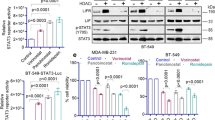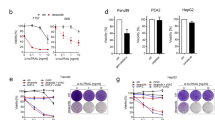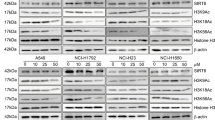Abstract
Histone deacetylase (HDAC) inhibitors induce differentiation and/or apoptosis in a variety of cell types by activating transcription of target genes. Activation of the death receptor (DR) pathway by tumor necrosis factor-related apoptosis-inducing ligand (TRAIL) induces apoptosis preferentially in cancer cells. Here, we investigated the intracellular mechanisms by which HDAC inhibitors (suberoylanilide hydroxamic acid, m-carboxycinnamic acid bis-hydroxamide, MS-275 and trichostatin A) enhance the apoptosis-inducing potential of TRAIL in breast cancer cells in vitro. A synergism in apoptosis was observed in both TRAIL-sensitive and -resistant cells upon sequential treatments with HDAC inhibitors followed by TRAIL. HDAC inhibitors synergized with TRAIL by inducing DRs DR4/TRAIL-R1 and DR5/TRAIL-R2 through NFκB activation and some of the proapoptotic members of the Bcl-2 family, and engaging the mitochondrial pathway. The ability of HDAC inhibitors to sensitize TRAIL-resistant cells suggests that HDAC inhibitors may induce fundamental alterations in cell signaling pathways. Thus, the sequential treatments with HDAC inhibitors followed by TRAIL may be used as a new therapeutic approach for the treatment of human cancers.
This is a preview of subscription content, access via your institution
Access options
Subscribe to this journal
Receive 50 print issues and online access
$259.00 per year
only $5.18 per issue
Buy this article
- Purchase on Springer Link
- Instant access to full article PDF
Prices may be subject to local taxes which are calculated during checkout






Similar content being viewed by others
Abbreviations
- DR:
-
death receptor
- DcR:
-
decoy receptor
- TRAIL:
-
tumor necrosis factor-related apoptosis-inducing ligand
- Apo-2L:
-
Apo2 ligand
- HDAC:
-
histone deacetylase
- TSA:
-
trichostatin A
- CBHA:
-
m-carboxycinnamic acid bis-hydroxamide
- SAHA:
-
suberoylanilide hydroxamic acid
- IAP:
-
inhibitor of apoptosis protein
- PARP:
-
poly(ADP-ribose) polymerase
- z-VAD-fmk:
-
z-Val-Ala-Asp-fluoromethylketone
- z-IETD-fmk:
-
z-Ile-Glu-Thr-Asp-fluoromethylketone
References
Ashkenazi A and Dixit VM . (1999). Curr. Opin. Cell Biol., 11, 255–260.
Ashkenazi A, Pai RC, Fong S, Leung S, Lawrence DA, Marsters SA, Blackie C, Chang L, McMurtrey AE, Hebert A, DeForge L, Koumenis IL, Lewis D, Harris L, Bussiere J, Koeppen H, Shahrokh Z and Schwall RH . (1999). J. Clin. Invest., 104, 155–162.
Bernhard D, Loffler M, Hartmann BL, Yoshida M, Kofler R and Csordas A . (1999). Cell Death Differ., 6, 609–617.
Bernhard D, Skvortsov S, Tinhofer I, Hubl H, Greil R, Csordas A and Kofler R . (2001). Cell Death Differ., 8, 1014–1021.
Bouillet P, Purton JF, Godfrey DI, Zhang LC, Coultas L, Puthalakath H, Pellegrini M, Cory S, Adams JM and Strasser A . (2002). Nature, 415, 922–926.
Burgess AJ, Pavey S, Warrener R, Hunter LJ, Piva TJ, Musgrove EA, Saunders N, Parsons PG and Gabrielli BG . (2001). Mol. Pharmacol., 60, 828–837.
Butler LM, Agus DB, Scher HI, Higgins B, Rose A, Cordon-Cardo C, Thaler HT, Rifkind RA, Marks PA and Richon VM . (2000). Cancer Res., 60, 5165–5170.
Chen X, Kandasamy K and Srivastava RK . (2003). Cancer Res., 63, 1059–1066.
Chen X, Thakkar H, Tyan F, Gim S, Robinson H, Lee C, Pandey SK, Nwokorie C, Onwudiwe N and Srivastava RK . (2001). Oncogene, 20, 6073–6083.
Cheng EH, Wei MC, Weiler S, Flavell RA, Mak TW, Lindsten T and Korsmeyer SJ . (2001). Mol. Cell, 8, 705–711.
Chinnaiyan AM, Prasad U, Shankar S, Hamstra DA, Shanaiah M, Chenevert TL, Ross BD and Rehemtulla A . (2000). Proc. Natl. Acad. Sci. USA, 97, 1754–1759.
Cogswell PC, Guttridge DC, Funkhouser WK and Baldwin Jr AS . (2000). Oncogene, 19, 1123–1131.
Cohen LA, Amin S, Marks PA, Rifkind RA, Desai D and Richon VM . (1999). Anticancer Res., 19, 4999–5005.
Degenhardt K, Chen G, Lindsten T and White E . (2002). Cancer Cell, 2, 193–203.
Degli-Esposti MA, Dougall WC, Smolak PJ, Waugh JY, Smith CA and Goodwin RG . (1997a). Immunity, 7, 813–820.
Degli-Esposti MA, Smolak PJ, Walczak H, Waugh J, Huang CP, DuBose RF, Goodwin RG and Smith CA . (1997b). J. Exp. Med., 186, 1165–1170.
Deveraux QL, Leo E, Stennicke HR, Welsh K, Salvesen GS and Reed JC . (1999). EMBO J., 18, 5242–5251.
Deveraux QL and Reed JC . (1999). Genes Dev., 13, 239–252.
Deveraux QL, Roy N, Stennicke HR, Van Arsdale T, Zhou Q, Srinivasula SM, Alnemri ES, Salvesen GS and Reed JC . (1998). EMBO J., 17, 2215–2223.
Deveraux QL, Takahashi R, Salvesen GS and Reed JC . (1997). Nature, 388, 300–304.
Dijkers PF, Birkenkamp KU, Lam EW, Thomas NS, Lammers JW, Koenderman L and Coffer PJ . (2002). J. Cell Biol., 156, 531–542.
Dijkers PF, Medema RH, Lammers JW, Koenderman L and Coffer PJ . (2000). Curr. Biol., 10, 1201–1204.
Du C, Fang M, Li Y, Li L and Wang X . (2000). Cell, 102, 33–42.
Franco AV, Zhang XD, Van Berkel E, Sanders JE, Zhang XY, Thomas WD, Nguyen T and Hersey P . (2001). J. Immunol., 166, 5337–5345.
Gessner PK . (1995). Toxicology, 105, 161–179.
Gil J, Rullas J, Alcami J and Esteban M . (2001). J. Gen. Virol., 82, 3027–3034.
Glass CK and Rosenfeld MG . (2000). Genes Dev., 14, 121–141.
Glick RD, Swendeman SL, Coffey DC, Rifkind RA, Marks PA, Richon VM and La Quaglia MP . (1999). Cancer Res., 59, 4392–4399.
Gray SG and Ekstrom TJ . (2001). Exp. Cell Res., 262, 75–83.
Green DR and Reed JC . (1998). Science, 281, 1309–1312.
Grignani F, De Matteis S, Nervi C, Tomassoni L, Gelmetti V, Cioce M, Fanelli M, Ruthardt M, Ferrara FF, Zamir I, Seiser C, Lazar MA, Minucci S and Pelicci PG . (1998). Nature, 391, 815–818.
Gross A, McDonnell JM and Korsmeyer SJ . (1999a). Genes Dev., 13, 1899–1911.
Gross A, Yin XM, Wang K, Wei MC, Jockel J, Milliman C, Erdjument-Bromage H, Tempst P and Korsmeyer SJ . (1999b). J. Biol. Chem., 274, 1156–1163.
Hernandez A, Wang QD, Schwartz SA and Evers BM . (2001). J. Gastrointest. Surg., 5, 56–65.
Herrera B, Fernandez M, Benito M and Fabregat I . (2002). FEBS Lett., 520, 93–96.
Johnstone RW . (2002). Nat. Rev. Drug Discov., 1, 287–299.
Kandasamy K, Srinivasula SM, Alnemri ES, Thompson CB, Korsmeyer SJ, Bryant JL and Srivastava RK . (2003). Cancer Res., 63, 1712–1721.
Kandasamy K and Srivastava RK . (2002). Cancer Res., 62, 4929–4937.
Kasof GM and Gomes BC . (2001). J. Biol. Chem., 276, 3238–3246.
Kaufmann SH, Desnoyers S, Ottaviano Y, Davidson NE and Poirier GG . (1993). Cancer Res., 53, 3976–3985.
Keane MM, Ettenberg SA, Nau MM, Russell EK and Lipkowitz S . (1999). Cancer Res., 59, 734–741.
Kim MS, Kwon HJ, Lee YM, Baek JH, Jang JE, Lee SW, Moon EJ, Kim HS, Lee SK, Chung HY, Kim CW and Kim KW . (2001). Nat. Med., 7, 437–443.
Kim YB, Lee KH, Sugita K, Yoshida M and Horinouchi S . (1999). Oncogene, 18, 2461–2470.
Kim YH, Park JW, Lee JY and Kwon TK . (2004). Carcinogenesis, 25, 1813–1820.
Korsmeyer SJ, Wei MC, Saito M, Weiler S, Oh KJ and Schlesinger PH . (2000). Cell Death Differ., 7, 1166–1173.
Kouzarides T . (1999). Curr. Opin. Genet. Dev., 9, 40–48.
Kramer OH, Gottlicher M and Heinzel T . (2001). Trends Endocrinol. Metab., 12, 294–300.
Kwon HJ, Owa T, Hassig CA, Shimada J and Schreiber SL . (1998). Proc. Natl. Acad. Sci. USA, 95, 3356–3361.
Lagger G, O'Carroll D, Rembold M, Khier H, Tischler J, Weitzer G, Schuettengruber B, Hauser C, Brunmeir R, Jenuwein T and Seiser C . (2002). EMBO J., 21, 2672–2681.
Li H, Zhu H, Xu CJ and Yuan J . (1998). Cell, 94, 491–501.
Lin RJ, Nagy L, Inoue S, Shao W, Miller Jr WH and Evans RM . (1998). Nature, 391, 811–814.
Luo J, Su F, Chen D, Shiloh A and Gu W . (2000). Nature, 408, 377–381.
Luo X, Budihardjo I, Zou H, Slaughter C and Wang X . (1998). Cell, 94, 481–490.
Maier JK, Lahoua Z, Gendron NH, Fetni R, Johnston A, Davoodi J, Rasper D, Roy S, Slack RS, Nicholson DW and MacKenzie AE . (2002). J. Neurosci., 22, 2035–2043.
Marks PA, Richon VM, Breslow R and Rifkind RA . (2001). Curr. Opin. Oncol., 13, 477–483.
Marsters SA, Sheridan JP, Pitti RM, Huang A, Skubatch M, Baldwin D, Yuan J, Gurney A, Goddard AD, Godowski P and Ashkenazi A . (1997). Curr. Biol., 7, 1003–1006.
McKinsey TA, Zhang CL, Lu J and Olson EN . (2000). Nature, 408, 106–111.
Nagane M, Pan G, Weddle JJ, Dixit VM, Cavenee WK and Huang HJ . (2000). Cancer Res., 60, 847–853.
Nakajima H, Kim YB, Terano H, Yoshida M and Horinouchi S . (1998). Exp. Cell Res., 241, 126–133.
Neuzil J, Swettenham E and Gellert N . (2004). Biochem. Biophys. Res. Commun., 314, 186–191.
Newmark HL, Lupton JR and Young CW . (1994). Cancer Lett., 78, 1–5.
Nicholson DW, Ali A, Thornberry NA, Vaillancourt JP, Ding CK, Gallant M, Gareau Y, Griffin PR, Labelle M and Lazebnik YA . (1995). Nature, 376, 37–43.
Pan G, Ni J, Wei YF, Yu G, Gentz R and Dixit VM . (1997a). Science, 277, 815–818.
Pan G, O'Rourke K, Chinnaiyan AM, Gentz R, Ebner R, Ni J and Dixit VM . (1997b). Science, 276, 111–113.
Ravi R, Bedi GC, Engstrom LW, Zeng Q, Mookerjee B, Gelinas C, Fuchs EJ and Bedi A . (2001). Nat. Cell Biol., 3, 409–416.
Reed JC . (2000). Am. J. Pathol., 157, 1415–1430.
Reed JC, Zha H, Aime-Sempe C, Takayama S and Wang HG . (1996). Adv. Exp. Med. Biol., 406, 99–112.
Rosato RR, Almenara JA and Grant S . (2003). Cancer Res., 63, 3637–3645.
Rosato RR and Grant S . (2003). Cancer Biol. Ther., 2, 30–37.
Roy N, Deveraux QL, Takahashi R, Salvesen GS and Reed JC . (1997). EMBO J., 16, 6914–6925.
Saito A, Yamashita T, Mariko Y, Nosaka Y, Tsuchiya K, Ando T, Suzuki T, Tsuruo T and Nakanishi O . (1999). Proc. Natl. Acad. Sci. USA, 96, 4592–4597.
Salvesen GS . (1999). Apmis, 107, 73–79.
Shankar S, Chen X and Srivastava RK . (2005). Prostate, 62, 165–186.
Shankar S, Singh TR, Chen X, Thakkar H, Firnin J and Srivastava RK . (2004a). Int. J. Oncol., 24, 1133–1140.
Shankar S, Singh TR and Srivastava RK . (2004b). Prostate, 61, 35–49.
Shankar S and Srivastava RK . (2004). Drug Resist. Updat., 7, 139–156.
Sheridan JP, Marsters SA, Pitti RM, Gurney A, Skubatch M, Baldwin D, Ramakrishnan L, Gray CL, Baker K, Wood WI, Goddard AD, Godowski P and Ashkenazi A . (1997). Science, 277, 818–821.
Singh TR, Shankar S, Chen X, Asim M and Srivastava RK . (2003). Cancer Res., 63, 5390–5400.
Sovak MA, Bellas RE, Kim DW, Zanieski GJ, Rogers AE, Traish AM and Sonenshein GE . (1997). J. Clin. Invest., 100, 2952–2960.
Srivastava RK . (2000). Mol. Cell Biol. Res. Commun., 4, 67–75.
Srivastava RK . (2001). Neoplasia, 3, 535–546.
Srivastava RK, Mi QS, Hardwick JM and Longo DL . (1999a). Proc. Natl. Acad. Sci. USA, 96, 3775–3780.
Srivastava RK, Sasaki CY, Hardwick JM and Longo DL . (1999b). J. Exp. Med., 190, 253–265.
Srivastava RK, Sollott SJ, Khan L, Hansford R, Lakatta EG and Longo DL . (1999c). Mol. Cell. Biol., 19, 5659–5674.
Stahl M, Dijkers PF, Kops GJ, Lens SM, Coffer PJ, Burgering BM and Medema RH . (2002). J. Immunol., 168, 5024–5031.
Strahl BD and Allis CD . (2000). Nature, 403, 41–45.
Suliman A, Lam A, Datta R and Srivastava RK . (2001). Oncogene, 20, 2122–2133.
Tallarida RJ . (2002). Pain, 98, 163–168.
Thomas WD, Zhang XD, Franco AV, Nguyen T and Hersey P . (2000). J. Immunol., 165, 5612–5620.
Van Lint C, Emiliani S and Verdin E . (1996). Gene Expr., 5, 245–253.
Verhagen AM, Ekert PG, Pakusch M, Silke J, Connolly LM, Reid GE, Moritz RL, Simpson RJ and Vaux DL . (2000). Cell, 102, 43–53.
Walczak H, Degli-Esposti MA, Johnson RS, Smolak PJ, Waugh JY, Boiani N, Timour MS, Gerhart MJ, Schooley KA, Smith CA, Goodwin RG and Rauch CT . (1997). EMBO J., 16, 5386–5397.
Walczak H, Miller RE, Ariail K, Gliniak B, Griffith TS, Kubin M, Chin W, Jones J, Woodward A, Le T, Smith C, Smolak P, Goodwin RG, Rauch CT, Schuh JC and Lynch DH . (1999). Nat. Med., 5, 157–163.
Wang CY, Guttridge DC, Mayo MW and Baldwin Jr AS . (1999). Mol. Cell. Biol., 19, 5923–5929.
Wang CY, Mayo MW and Baldwin Jr AS . (1996). Science, 274, 784–787.
Wei MC, Zong WX, Cheng EH, Lindsten T, Panoutsakopoulou V, Ross AJ, Roth KA, MacGregor GR, Thompson CB and Korsmeyer SJ . (2001). Science, 292, 727–730.
Yang Y, Fang S, Jensen JP, Weissman AM and Ashwell JD . (2000). Science, 288, 874–877.
Yoshida M . (1994). Leukemia, 8 (Suppl 1), S51–S53.
Zhang XD, Gillespie SK, Borrow JM and Hersey P . (2003). Biochem. Pharmacol., 66, 1537–1545.
Acknowledgements
This work was supported by grants from the Susan G Komen Breast Cancer Foundation, and the Department of Defense. We extend our sincere thanks to Dr Warner C Greene (Gladstone Institute of Virology and Immunology, University of California, San Francisco, CA) for providing mutant IκBα (S32/36). We also thank Craig Thompson (University of Pennsylvania, Philadelphia, PA, USA) and Stanley Korsmeyer (Dana-Farber Cancer Institute, Boston, MA) for providing the Bcl-XL and Bcl-2 expression vectors, respectively. We thank Dr Vishva Dixit (Genentech, South San Francisco, CA, USA) for providing dominant-negative FADD.
Author information
Authors and Affiliations
Corresponding author
Rights and permissions
About this article
Cite this article
Singh, T., Shankar, S. & Srivastava, R. HDAC inhibitors enhance the apoptosis-inducing potential of TRAIL in breast carcinoma. Oncogene 24, 4609–4623 (2005). https://doi.org/10.1038/sj.onc.1208585
Received:
Revised:
Accepted:
Published:
Issue Date:
DOI: https://doi.org/10.1038/sj.onc.1208585
Keywords
This article is cited by
-
Generation of TRAIL-resistant cell line models reveals distinct adaptive mechanisms for acquired resistance and re-sensitization
Oncogene (2021)
-
The application of histone deacetylases inhibitors in glioblastoma
Journal of Experimental & Clinical Cancer Research (2020)
-
Targeting epigenetic regulators for cancer therapy: mechanisms and advances in clinical trials
Signal Transduction and Targeted Therapy (2019)
-
Natural Agents-Mediated Targeting of Histone Deacetylases
Archivum Immunologiae et Therapiae Experimentalis (2018)
-
Synergistic effects of combined treatment with histone deacetylase inhibitor suberoylanilide hydroxamic acid and TRAIL on human breast cancer cells
Scientific Reports (2016)



